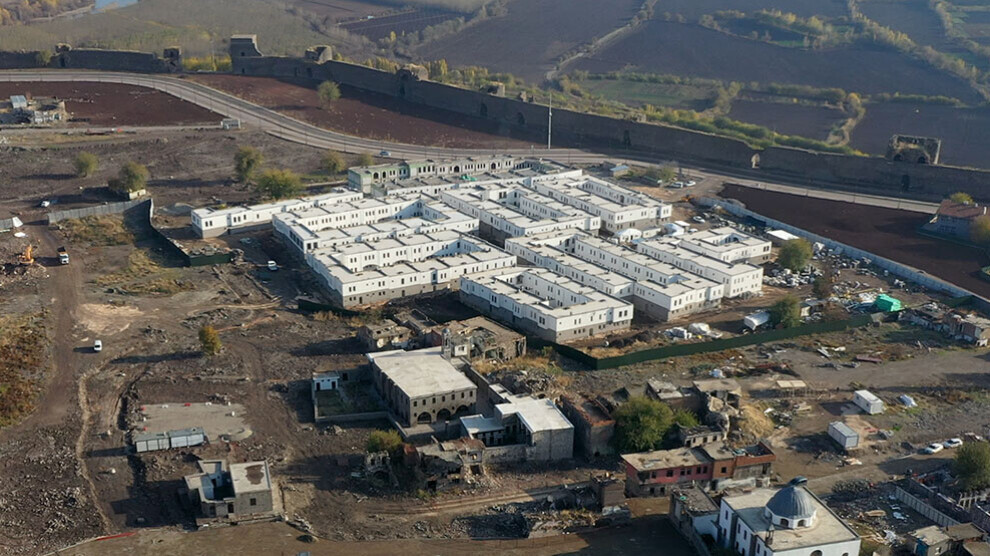Residential area in Sur resembles a prison
Five years after the destruction of the old town district of Sur in Amed, a new residential area has been built based on the model of the state prison architecture.
Five years after the destruction of the old town district of Sur in Amed, a new residential area has been built based on the model of the state prison architecture.

City planning is used by states and regimes as a weapon to secure rule over the population. A current example of this policy is the district of Sur in Amed. The old town district with its winding streets was a UNESCO World Heritage Site and was a stronghold of the Kurdish resistance.
Malls and standard blocks of flats instead of the Kurdish old city
In 2015-2016, the Turkish army and police razed parts of the district to the ground, but many buildings were only destroyed after the fighting ended. Residential complexes inspired by prison architecture are now being built. Here the population is to be standardized and atomized.
Five years of entry ban
At that time, the historic Sûr district experienced a lengthy curfew. On 2 December 2015, the districts of Cevat Paşa, Dabanoğlu, Fatihpaşa, Hasırlı, Savaş and Cemal Yılmaz were completely blocked. On December 11, the ban was suspended for a day and civilians had to leave their neighbourhoods. Since then, there has been a ban on entering districts cordoned off with iron barriers. To date, there has been no explanation from the authorities as to when the ban will be lifted. On March 21, 2016, the Council of Ministers passed an urgent procedure to “nationalize” 6,292 of the 7,714 properties in the area. After the land was nationalized, the six residential areas were razed to the ground. Historic churches, mosques, baths and hostels were completely destroyed.

3,569 buildings destroyed
According to the Chamber of Engineers and Architects (TMMOB), 3,569 buildings were destroyed. Most of the buildings were demolished after the fighting ended and the curfews were partially lifted. Instead of the destroyed buildings, basalt-clad houses and malls began to be built. At the same time, the construction of monochrome, uniform blocks of flats in the area continues.
Over 5,000 families lost their homes
The more than 5,000 families who had to flee during the prohibition period were given three options for “compensation”. The families were offered either money for their property, a place in TOKI apartment blocks outside the city or in newly built apartments. The majority of families did not want money, but applied for housing in the places where they had previously lived. However, 2,000 TL (around 200 euros) per square meter was required for the square meter in the new apartments. Because of these costs, homeless families who did not have the financial means had to access the TOKI blocks outside the city and were housed in Üçkuyular and Çölgüzeli in front of the city. For this, too, families had to go into debt with four-digit lira amounts.
Former old town becomes an object of speculation
The inside of the new apartments, shops and malls were unaffordable for the original owners. Therefore, they were auctioned on the real estate market and became objects of speculation. What will happen to the buildings under construction is still unknown.
A residential area with prison architecture
More than five years after the area was cordoned off, the new buildings and construction sites in the neighbourhoods were photographed from the air. The recordings show that many other structures have been demolished and some historical sites have been restored. The architectural model of the monochrome, uniform houses catches the eye. The houses are practically built wall to wall, have an inner courtyard and are closed to the outside. These are typical elements of prison architecture.
46 hectares of devastation
In an interview with the Mezopotamya news agency, the co-chair of the Amed Chamber of Architects, Ferit Kahraman, said that after the clashes ended, an area of 46 hectares was demolished. In addition, 89 registered buildings were damaged. Many of the buildings were demolished to build roads for "safety reasons" or to create routes for construction machinery. 49 historic buildings in the forbidden zone are currently being restored. Kahraman said that restoration started “about a year ago and is actually too late."
Kahraman states that the new buildings are neither in accordance with civil architecture nor the traditional forms of construction. He criticizes that Sur's previously agreed protection and conservation plan is also not being respected. “The houses have an inner courtyard and are close to one another. When talking about traditional houses or examples of original civil architecture, we should also be talking about the concept of privacy. At the moment, eight or ten houses are lined up around a courtyard and all the windows look into it. There is no privacy in this form of architecture."
Plans from Ankara
Kahraman explains that the non-participation of civil society in the design and construction phase led to such an architecture. He added: “All planning, projects and processes are centrally controlled from Ankara. Many of those who designed the project are people who have never seen Amed and its architectural structure.”
A place with no soul
The architect continues: “When you go in there, you see that there is no warmth there. This place has no soul.” The project was built primarily according to the paradigm of profit. During the construction process it was promised that the original population would not suffer. However, this promise was not kept, said Kahraman.